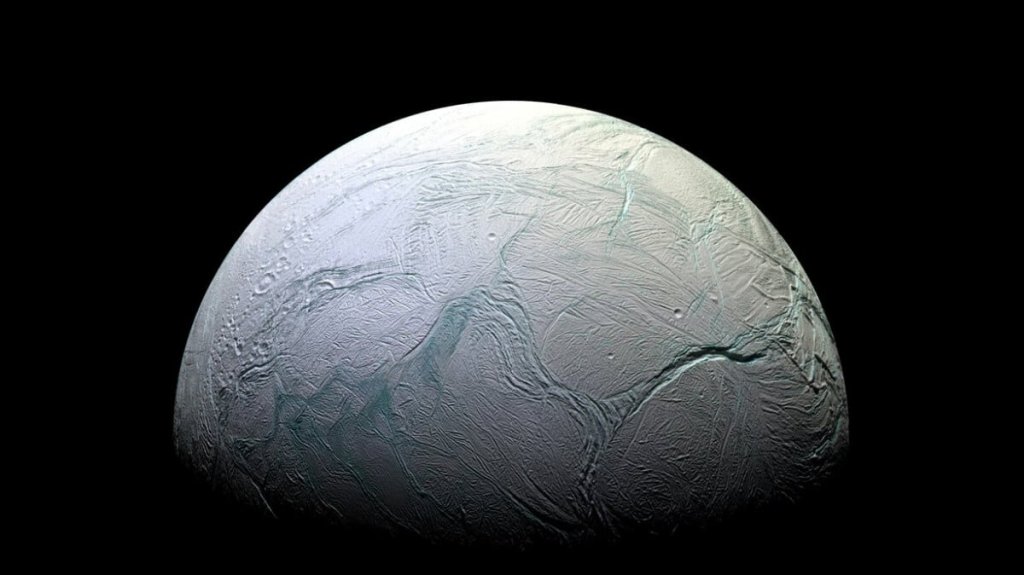The moon Enceladus shoots giant plumes of its ocean into space.
Planetary scientists suspect this briny sea could be habitable, meaning it potentially harbors conditions that support life. Now, new research suggests this Saturnian moon’s water contains bounties of a critical building block for life (as we know it, anyway). It’s phosphorus, an important ingredient in genetic and cellular material. It’s the second most abundant mineral in our bodies.
“We found evidence that one of the key elements that’s needed for life on Earth should be present in high abundance in the ocean of Enceladus,” Christopher Glein, a senior scientist at the Southwest Research Institute, a research and development organization, told Mashable.
“It shows Enceladus is more habitable than previously thought,” added Glein, who studies the geology of other worlds. The research, which simulated how minerals dissolve into the moon’s sea and allowed researchers to estimate the quantity of phosphorus on Enceladus, was recently published(opens in a new tab) in the Proceedings of the National Academy of Sciences.
Update June 14, 2023 at 12:30 p.m. ET: While this research simulated conditions on Enceladus that determined the moon likely contains phosphorous, new follow-up research(opens in a new tab) actually found this critical chemical in erupted ice grains. “But now, this new result reveals the clear chemical signature of substantial amounts of phosphorus salts inside icy particles ejected into space by the small moon’s plume,” Frank Postberg, a planetary scientist who led the new research, said in a statement(opens in a new tab). “It’s the first time this essential element has been discovered in an ocean beyond Earth.”
When NASA’s legendary Cassini mission flew through one of Saturn’s nearby rings, the spacecraft picked up evidence of these phosphates, chemicals researchers say came from Enceladus and exist there in high quantities. “This key ingredient could be abundant enough to potentially support life in Enceladus’ ocean; this is a stunning discovery for astrobiology,” Glein said in a new statement.
The data for the study come from a legendary NASA mission back in 2008, when the space agency’s legendary Cassini probe dove through jets of icy water vapor, gases, and organic material that sprayed from Enceladus’ south pole. The moon, which is as wide as Arizona, instantly became a source of intense intrigue. “Enceladus discoveries have changed the direction of planetary science,” Linda Spilker, Cassini’s project scientist, said in a statement(opens in a new tab). “Planetary scientists now have Enceladus to consider as a possible habitat for life,” she added.
“Phosphorus has a critical role in life as we know it.”
Yet Cassini’s brief plunge through the moon’s plumes didn’t nearly capture everything in the ocean. And previous research(opens in a new tab) concluded there wasn’t much phosphorus in Enceladus’ seas, which doesn’t bode as well for the ocean world’s habitability.
This latest research, however, used updated, more detailed computer simulations of how Enceladus’ rocky seafloor geology interacts with the salty seas, a natural process that dissolves phosphorus minerals into the water. Of course, scientists don’t have any direct samples of Enceladus’ core — that would require an unprecedented robotic mission to land on a far-off moon. But, we know the core is rocky (because of how Cassini interacted with Enceladus’ gravity), and researchers have bounties of meteorites on Earth and clues from other extraterrestrial rocks that provide compelling clues about what the rocky places in our solar system are composed of.
“We don’t know exactly what the rocky core of Enceladus is made of, but we can make good guesses based on what we find in other places in the solar system,” Geoff Collins, a planetary scientist at Wheaton College in Massachusetts who had no role in the research, told Mashable. What’s more, Collins noted, Chinese scientists just discovered a new phosphate mineral(opens in a new tab) on the moon.
Taken together, Glein and his research team are confident they know what’s dissolving into Enceladus’ ocean. And it’s plenty of phosphorus. “Phosphorus has a critical role in life as we know it,” he emphasized.

Credit: SwRI
Credit: NASA
Want more science and tech news delivered straight to your inbox? Sign up for Mashable’s Light Speed newsletter today
Enceladus orbits deep in the solar system, at some 800 million miles from Earth. So, for the foreseeable future, planetary scientists must comb through the data collected by the Cassini probe (as it investigated Saturn and its moons) to deduce what this alien ocean is truly like. “We’d like people to continue studying the data from Cassini,” said Glein, who noted this research is another step in the longer-term scrutiny of this captivating moon.
One day, perhaps in the late 2040s or 2050s, a space agency like NASA may send a probe to land on Enceladus. Just visiting the moon’s south pole, and directly sampling the snow falling from its icy plumes, would give researchers unprecedented insight into what’s transpiring in the oceans below. The U.S. National Academies of Sciences, Engineering, and Medicine recently proposed, in an influential planning document(opens in a new tab), that a probe visit and land on Enceladus. (Already, NASA is sending an orbiter to Jupiter’s satellite Europa in 2024 to “investigate whether the icy moon could harbor conditions suitable for life.”)
Going to Enceladus is decades off. But that’s planetary science.
“People wait their whole careers to answer these deep questions,” said Glein. “You have to have an abundance of patience.”
This story was originally published in September 2022 and has been updated with follow-up research showing direct evidence of phosphates in Enceladus’ seas.

